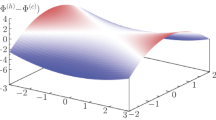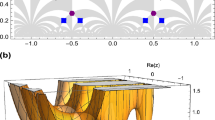Abstract.
A method is presented to construct nonconvex free energies that are invariant under a symmetry group. Algebraic and geometric methods are used to determine invariant functions with the right location of minimizers. The methods are illustrated for symmetry-breaking martensitic phase transformations. Computer algebra is used to compute a basis of the corresponding class of invariant functions. Several phase transitions, such as cubic-to-orthorhombic, are discussed. An explicit example of an energy for the cubic-to-tetragonal phase transition is given.
Similar content being viewed by others
References
Abud, M., Sartori, G.: The geometry of orbit-space and natural minima of Higgs potentials. Phys. Lett. B 104, 147–152 (1981)
Abud, M., Sartori, G.: The geometry of spontaneous symmetry breaking. Ann. Physics 150, 307–372 (1983)
Atiyah, M.F., Macdonald, I.G.: Introduction to commutative algebra. Addison-Wesley Publishing Co., Reading, Mass.-London-Don Mills, Ont., 1969
Chevalley, C.: Invariants of finite groups generated by reflections. Am. J. Math. 77, 778–782 (1955)
Conti, S., Zanzotto, G.: Reconstructive phase transformations, maximal Ericksen-Pitteri neighborhoods, dislocations and plasticity in crystals. Technical Report 42/2002, Max-Planck Institut für Mathematik in den Naturwissenschaften, Leipzig, 2002
Cox, D., Little, J., O’Shea, D.: Ideals, varieties, and algorithms. second edition, New York: Springer-Verlag, 1997. (An introduction to computational algebraic geometry and commutative algebra)
Dondl, P., Zimmer, J.: Modeling and simulation of martensitic phase transitions with a triple point. Submitted to J. Mech. Phys. Solids
Eisenbud, D.: Commutative algebra. New York: Springer-Verlag, 1995. (With a view toward algebraic geometry)
Falk, F., Konopka, P.: Three-dimensional Landau theory describing the martensic phase transformation of shape-memory alloys. J. Phy. – Condensed Matter 2, 61–77 (1990)
Field, M.: Lectures on bifurcations, dynamics and symmetry. Volume 356 of Pitman Research Notes in Mathematics Series. Longman, Harlow, 1996
Gatermann, K.: Computer algebra methods for equivariant dynamical systems. Berlin: Springer-Verlag, 2000
Greuel, G.-M., Pfister, G., Schönemann, H.: Singular 2.0. A Computer Algebra System for Polynomial Computations, Centre for Computer Algebra, University of Kaiserslautern, 2001. http://www.singular.uni-kl.de
Hochster, M., Eagon, J.A.: Cohen-Macaulay rings, invariant theory, and the generic perfection of determinantal loci. Am. J. Math. 93, 1020–1058 (1971)
Jänich, K.: Differenzierbare G-Mannigfaltigkeiten. Berlin: Springer-Verlag, 1968
Jarić, M.V., Michel, L., Sharp, R.T.: Zeros of covariant vector fields for the point groups: invariant formulation. J. Physique 45, 1–27 (1984)
Landau, L.D.: On the theory of phase transitions. In: Haar, D.T. (ed.), Collected papers of L. D. Landau. New York: Gordon and Breach Science Publishers, 1967
Lyubarskiu i, G.Y.: The application of group theory in physics. New York: Pergamon Press, 1960
Pitteri, M., Zanzotto, G.: Models for Phase Transitions and Twinning in Crystals. CRC Press, Boca Rota, 2002
Procesi, C., Schwarz, G.: Inequalities defining orbit spaces. Invent. Math. 81, 539–554 (1985)
Procesi, C., Schwarz, G.W.: The geometry of orbit spaces and gauge symmetry breaking in supersymmetric gauge theories. Phys. Lett. B 161, 117–121 (1985)
Rumberger, M.: Symmetrische dynamische Systeme: Differenzierbarkeit und linearisierte Stabilität. PhD thesis, Universität Hamburg, Fachbereich Mathematik, 1997
Rumberger, M.: Finitely differentiable invariants. Math. Z. 229, 675–694 (1998)
Schönert, M. et~al.: GAP – Groups, Algorithms, and Programming. Lehrstuhl D für Mathematik, Rheinisch Westfälische Technische Hochschule, Aachen, Germany, fifth edition, 1995 http://www-gap.dcs.st-and.ac.uk/~gap/
Schwarz, G.W.: Smooth functions invariant under the action of a compact Lie group. Topology 14, 63–68 (1975)
Smith, G.F., Rivlin, R.S.: The strain-energy function for anisotropic elastic materials. Trans. Am. Math. Soc. 88, 175–193 (1958)
Sturmfels, B.: Algorithms in invariant theory. Vienna: Springer-Verlag, 1993
Weyl, H.: The classical groups: Their invariants and representations. Fifteenth printing, Princeton Paperbacks, Princeton, NJ: Princeton University Press, 1997
Worfolk, P.A.: Zeros of equivariant vector fields: algorithms for an invariant approach. J. Symbolic Comput. 17, 487–511 (1994)
Zimmer, J.: Mathematische Modellierung und Analyse von Formgedächtnislegierungen in mehreren Raumdimensionen (Mathematical Modeling and Analysis of Shape Memory Alloys in Several Space Dimensions). PhD thesis, Technische Universität München, 2000
Author information
Authors and Affiliations
Corresponding author
Additional information
K. Bhattacharya
Rights and permissions
About this article
Cite this article
Zimmer, J. Stored Energy Functions for Phase Transitions in Crystals. Arch. Rational Mech. Anal. 172, 191–212 (2004). https://doi.org/10.1007/s00205-003-0286-1
Accepted:
Published:
Issue Date:
DOI: https://doi.org/10.1007/s00205-003-0286-1




